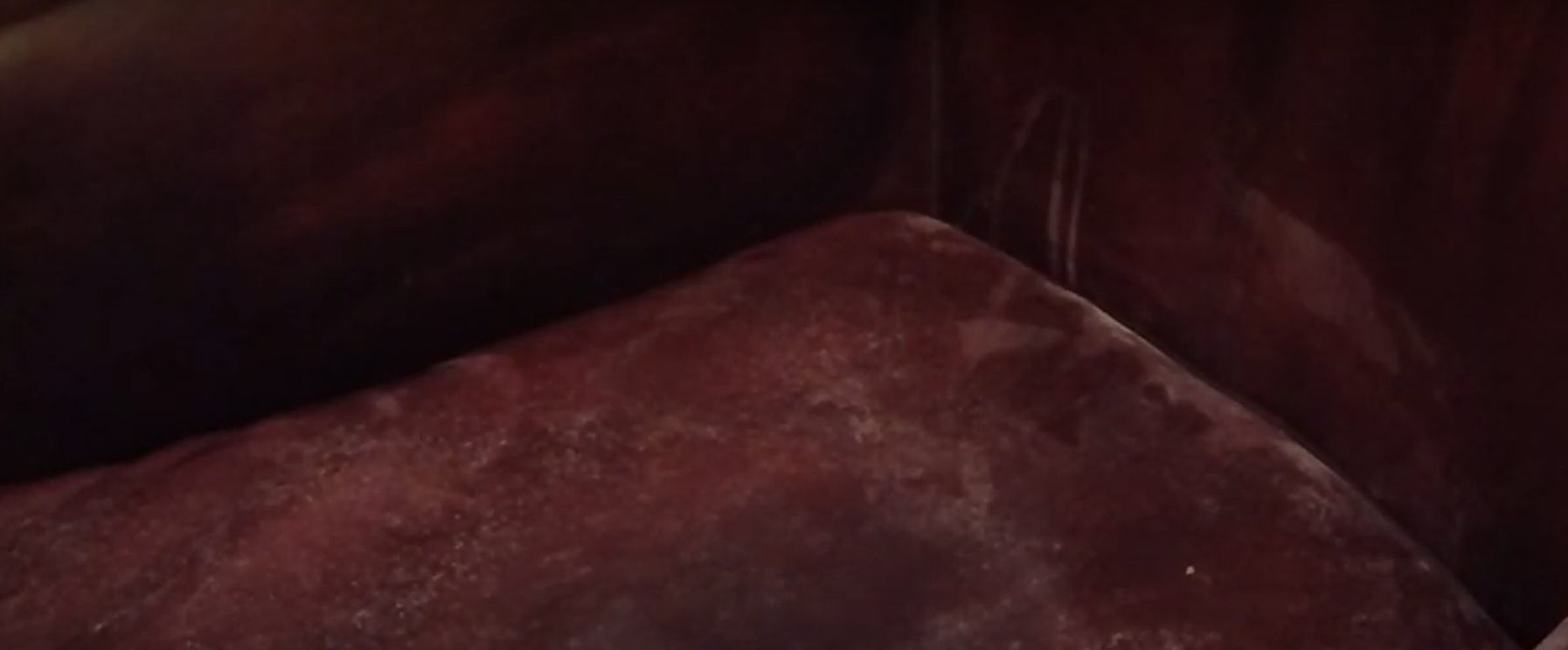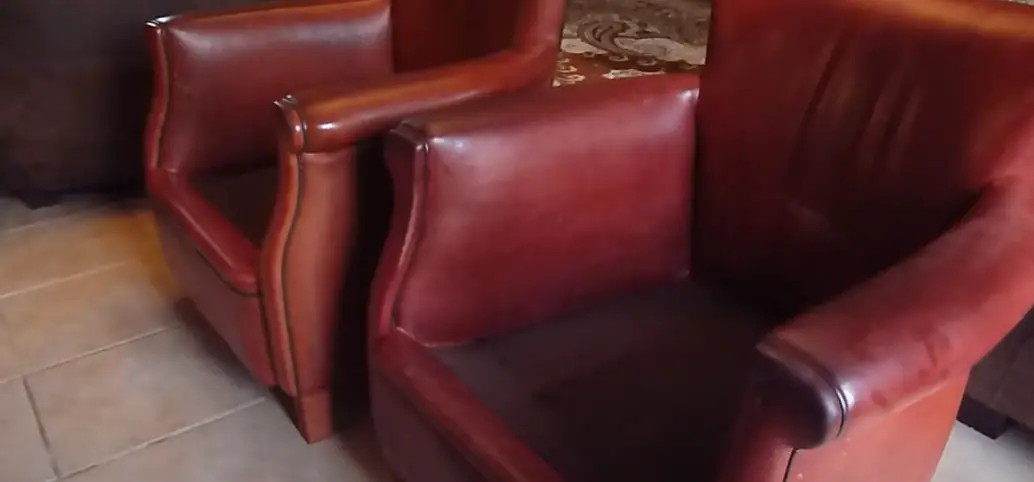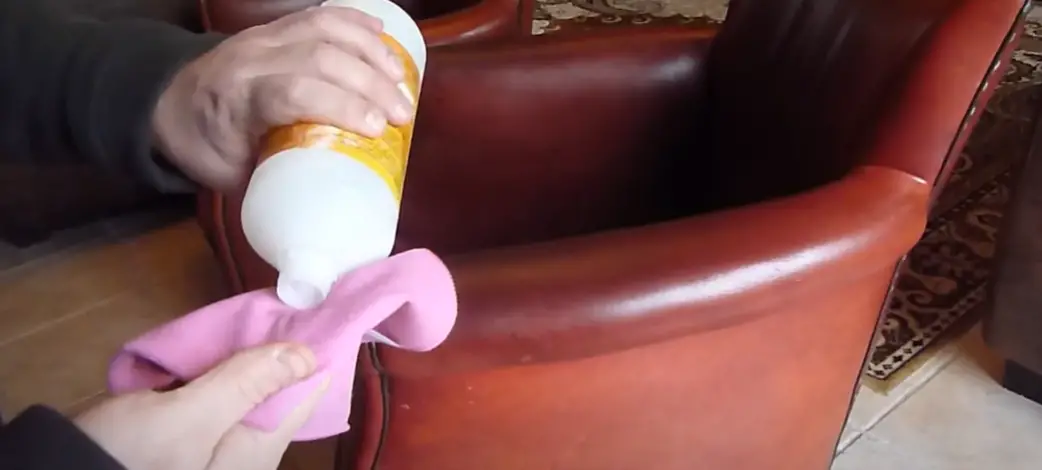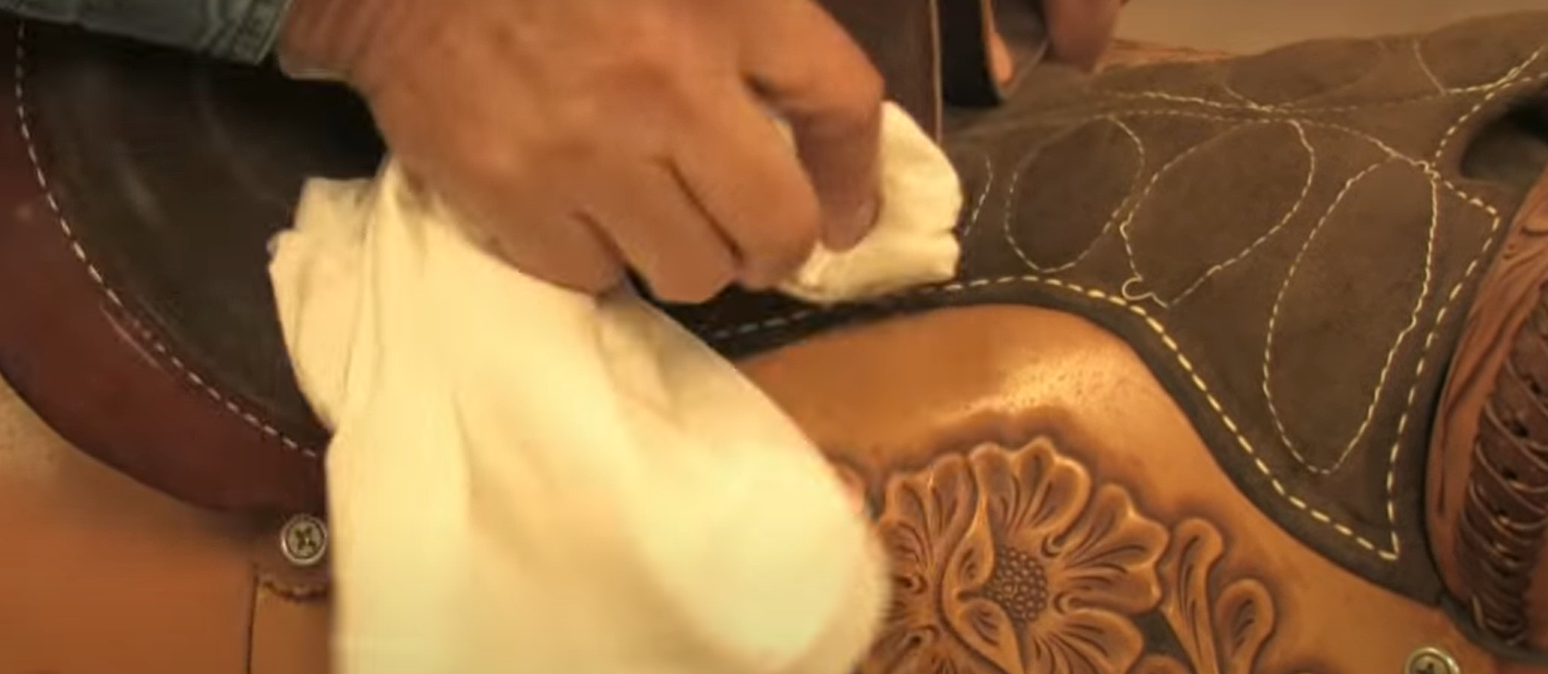Mold is a fungus that can grow almost anywhere, and leather is a common place for it to form. If you have a leather couch and you notice mold starting to grow, don’t panic! There are several things you can do to get rid of the mold and protect your furniture. In this article, we will discuss what causes mold on leather couches, how to identify it, and how to get rid of it safely and effectively. We will also provide some tips on how to prevent mold from forming in the future.
What Causes Mold Growth on Leather?
One fine day, you notice some black spots on your beautiful leather couch. You may think it’s dirt at first, but upon closer inspection, you realize it’s mold! Mold growth on leather is not uncommon, and it can happen for a few different reasons.

Porous surface of the leather
Leather is a natural material that is made from the skin of animals. It is durable and has unique characteristics that make it different from other materials like fabric or suede. However, because it is a natural product, it is also porous. This means that it can absorb water and moisture from the air, which can lead to mold growth.
Mold needs three things to grow: food, water, and warmth. Leather provides two out of three of these things – it contains proteins and fats that mold can feed on, and it can absorb moisture from the air. The third element, warmth, is usually provided by the temperature of the room where the leather is located.
High temperatures
Leather is a natural material, and as such, it’s subject to the whims of Mother Nature. If the temperature in your home gets too high (think: summertime), mold can start to grow on your leather couch. This is because mold loves warmth and high temperatures.
Lack of use and care
If your leather couch is not being used often, mold can start to grow. This is because the leather needs to be regularly conditioned in order to stay supple and avoid cracking. When leather dries out, it becomes a prime target for mold spores.
Mold growth on leather can also be caused by using cleaning products that are not intended for use on leather. These products can strip away the natural oils that protect the leather, making it more susceptible to mold growth.
Damp conditions
Mold thrives in damp conditions, so if your leather couch is located in a damp room or area of the house, it’s more susceptible to mold growth. So if you want to prevent mold growth on your leather couch, it’s important to keep the relative humidity in your home at a safe level.
The ideal range is 30-50%, but anything below 60% should be fine. You can measure the relative humidity in your home with a hygrometer, which is a relatively inexpensive tool that you can find at most hardware stores.
Poor ventilation can also lead to mold growth, so if your leather couch is in a room that doesn’t have good airflow, it’s more likely to develop mold. Make sure the room where your couch is located has a window that can be opened to allow fresh air in. [1], [2]
Why You Should Absolutely Deal With Mold on Leather Furniture
Most people are well aware of the dangers that mold poses to their health. However, many don’t realize that leather furniture is especially susceptible to mold growth.

As you may be aware by now, leather is a natural material that is made from animal skin. It’s porous and absorbent, which means it can easily soak up moisture from the air. If there is high humidity in your home or if your leather furniture is frequently exposed to water, then it’s at risk for developing mold growth.
Mold can cause serious health problems, including respiratory infections, headaches, and allergic reactions. In some cases, mold exposure can even lead to death. So it’s absolutely essential that you take action to get rid of mold on your leather couch as soon as you see it.
Tips for Cleaning Mold from Leather
If you have a mold problem on your leather couch, you may be wondering if it can be saved. The truth is, it depends on the extent of the damage.
Now that you know what causes mold to grow on leather and why it’s so important to deal with it, let’s talk about how to actually get rid of it!
Take your furniture outside
As we mentioned, exposure to mold can cause serious health problems. So the first step in cleaning mold from your leather couch is to take it outside. This will help to prevent mold spores from spreading through your home and making you sick.
If possible, take your couch apart so that you can clean each piece separately. If you can’t take it apart, then at least open all of the windows in the room to allow for good airflow.
Take an allergy medication if you are sensitive to mold
If you are allergic to mold or have asthma, it’s important to take an allergy medication before you begin cleaning. This will help to reduce your symptoms and make the cleaning process more tolerable. Make sure to consult with your doctor first to find out which allergy medication is right for you.
Leather cleaner method
One of the best ways to clean mold from leather is with a leather cleaner. Leather cleaners are designed to clean and protect leather, and they can be very effective at removing mold. Just be sure to read the instructions carefully and test the cleaner on a small area of the leather before using it on the entire couch.
Make sure you are using a pH balanced leather cleaner, as some cleaners can be too harsh and damage the leather. And you don’t want that!
First, water the moldy area. As ironic as it may sound, you need to wet the mold before you can clean it. This will help to loosen the mold and make it easier to remove.
Next, apply the leather cleaner to the area and scrub with a soft brush or cloth. You may need to let the cleaner sit for a few minutes before scrubbing, so be sure to read the instructions on your particular cleaner. Move in circular motions as you scrub, and be sure to get into all the nooks and crannies.
Once you’ve scrubbed the area clean, rinse it off with clean water. Be sure to remove all the cleaner from the leather, as leaving it on can damage the leather over time. Finally, dry the area completely. To not damage the leather we suggest you leave it to air dry.
Vinegar method
If you don’t have a leather cleaner on hand, you can also use vinegar to clean mold from your leather couch. Vinegar is a common household item that can be used for many purposes, including cleaning mold. Its acidic nature makes it effective at killing mold spores and preventing them from growing.
However there’s a downside when using vinegar to clean mold. Because vinegar is so acidic, it can damage leather if not used correctly. Therefore it’s important to be extremely careful when cleaning mold from leather with vinegar.
You also may want to wear protective gloves and a mask when using vinegar to clean mold, as the fumes can be irritating.
To clean mold on leather with vinegar, mix one part vinegar with one part water in a bowl. Make sure you add the equal parts slowly so you don’t accidentally add too much vinegar which could damage the leather.
Once the mixture is ready, apply it to a clean cloth and then gently rub it onto the moldy area of the leather couch. Be sure to only rub in one direction so you don’t end up damaging the leather further.
After you’ve rubbed the vinegar mixture into the moldy area, use a clean cloth soaked in warm water to wipe away any residue. Finally, allow the leather to air dry completely before using it again. [1], [2], [3]
Tips on Mold Prevention
After you’ve removed all the mold from your leather couch, it’s important to take steps to prevent it from coming back. By now you probably have figured out what exactly was the source of the initial mold problem, and you can take steps to address that issue so it doesn’t become a problem again. In addition, there are some general tips that can help prevent mold from growing on your leather couch in the future.

Keep an eye on humidity levels
Mold thrives in humid environments, so it’s important to keep your home’s humidity levels in check. The best way to do this is to invest in a hygrometer, which will help you monitor the humidity in your home and make adjustments as needed.
Getting yourself a humidifier can also help, especially if you live in a dry climate. Just be sure to keep an eye on the humidity levels (using your hygrometer) to avoid creating too much moisture, which can also lead to mold growth.
You can also take some simple steps to reduce the amount of moisture in your home, such as:
- Ventilating bathrooms and kitchens after cooking or showering
- Using exhaust fans when cooking or running the dishwasher
Clean regularly and thoroughly
The best way to prevent mold is to keep your leather couch clean and free of dirt, dust, and other debris that mold can latch onto. A regular cleaning schedule will help ensure that your couch stays mold-free.
When cleaning, be sure to use a soft cloth or brush attachment on your vacuum cleaner to avoid damaging the leather. You can also wipe down the couch with a damp cloth to remove any surface dirt and dust.
Condition your leather furniture
Leather furniture needs to be conditioned every few months to stay healthy and prevent cracking. So it’s pretty self-explanatory that if you want to avoid mold growth, you should make sure to keep your leather couch in good condition.
And it’s not just a matter of using any ol’ lotion or cream — you need to use a product specifically designed for leather. [1], [2], [3]
Dealing with Mold on Your Leather Couch
Discovering mold on your leather couch can be distressing, but you can take steps to address it effectively. To help you combat mold growth, we’ve compiled a guide with explanations for each essential action and the materials needed.
| Procedure | Explanation | Materials Needed | Time Required | Difficulty Level |
|---|---|---|---|---|
| 1. Identify the Mold | Locate and confirm the presence of mold on your leather couch. | N/A | 5 minutes | Easy |
| 2. Isolate and Ventilate | Isolate the affected area, open windows, and use fans to improve ventilation. | Fans, open windows | Ongoing (until mold is addressed) | Easy |
| 3. Protect Yourself | Wear protective gear such as gloves and a mask before handling mold. | Protective gear (gloves, mask) | Ongoing (during mold removal) | Easy |
| 4. Clean with Mild Soap | Dampen a cloth with water and mild soap, then gently wipe the affected area. | Mild soap, water, soft cloth | 15-30 minutes | Easy |
| 5. Use Vinegar Solution | Mix equal parts white vinegar and water, dampen a cloth, and gently wipe the moldy spots. | White vinegar, water, soft cloth | 15-30 minutes | Easy |
| 6. Dry Thoroughly | Allow the cleaned area to air dry completely. Use fans or a dehumidifier if needed. | Fans, dehumidifier (if necessary) | Varies (until completely dry) | Easy |
| 7. Leather Conditioner | Apply a leather conditioner to the affected area to restore moisture and prevent cracking. | Leather conditioner, applicator pad | 15-20 minutes | Easy |
| 8. Prevent Future Mold | Address any moisture sources, maintain proper ventilation, and consider using a dehumidifier. | Dehumidifier (if needed) | Ongoing (to prevent future mold growth) | Easy |
Explanation of the Table:
- Procedure: Outlines each step of the process for dealing with mold on your leather couch.
- Explanation: Provides a brief explanation of what to do in each step.
- Materials Needed: Lists the necessary materials and tools for each step of the process.
- Time Required: Indicates the estimated time needed for each step.
- Difficulty Level: Rates the difficulty of each step, with “Easy” indicating simple tasks.
By following these steps and considering the materials required, time involved, and the ease of each step, you can effectively address and prevent mold on your leather couch, ensuring it remains in good condition for years to come.
FAQ
What kills mold instantly?
Hydrogen peroxide and vinegar are effective mold killers. You can use either of these products to clean mold off of leather. Just be sure to dilute them with water first, as undiluted hydrogen peroxide or vinegar can damage leather.
However, keep in mind that both these products need to be diluted before using them on leather. Pour 3% concentration hydrogen peroxide into a spray bottle and add equal parts of water to it. Similarly, for vinegar, use a 50-50 mixture of water and white vinegar.

Can a moldy leather couch be saved?
If the mold has just started to grow on your leather couch, you may be able to save it with some quick action and the right cleaning supplies. However, if the mold has been growing for a while or has spread to other parts of the couch, it is probably best to replace it.
Can mold be removed from leather?
Mold can be removed from leather, but it is important to take care of the leather afterwords to make sure the mold does not come back. To remove mold from leather, mix a solution of equal parts water and vinegar in a bowl. Dip a clean cloth into the mixture and wring it out so that it is damp, not dripping wet. Rub the cloth over the moldy areas on the leather couch, then use a second clean, damp cloth to wipe away any residual mold or cleaner. Allow the area to air dry completely.
Does vinegar kill mold on leather?
Yes, vinegar is an effective mold kil
ler. In fact, vinegar is often used as a natural cleaning solution for many types of surfaces, including leather. To clean mold from your leather couch with vinegar, simply mix equal parts water and white vinegar in a bowl. Then, use a clean cloth to dab the mixture onto the affected areas of your couch. Dry the area thoroughly with a clean towel afterwards.
Is mold on leather toxic?
If you have mold growing on your leather couch, it is important to remove it as soon as possible. Not only is mold unsightly, but it can also be dangerous to your health. Some types of mold release toxins known as spores into the air. These spores can cause respiratory problems, skin irritation and other health problems.
How can I safely remove mold from my leather couch?
To safely remove mold from a leather couch, follow these steps:
1. Begin by ensuring safety. Wear protective gear such as gloves and a mask to avoid inhaling mold spores.
2. Ventilate the area where the leather couch is located, if possible. Good ventilation helps reduce exposure to mold spores.
3. Start by using a dry, clean cloth to gently wipe away loose surface mold. Discard the cloth properly to prevent further contamination.
4. Create a solution by mixing equal parts white vinegar and water. Dampen a clean cloth with this solution and gently wipe the affected areas. This helps kill mold and remove stains. Always test the solution on an inconspicuous area first.
5. Sprinkle baking soda on the affected areas and allow it to sit for several hours or overnight. Then, vacuum the baking soda to absorb moisture and remove residual mold.
6. Use a leather-specific cleaner or saddle soap to clean the leather thoroughly, following the product’s instructions carefully.
7. After cleaning, apply a leather conditioner to the couch to restore moisture and maintain its texture.
8. To prevent future mold growth, store the leather couch in a dry environment, maintain proper humidity levels, and avoid exposing it to excessive moisture.
What should I do if the mold on my leather couch is extensive or deeply embedded?
If mold on your leather couch is extensive or deeply embedded, it’s best to seek professional help. Mold remediation experts have the equipment and expertise to safely and effectively remove mold from leather and prevent its recurrence. Attempting to tackle severe mold issues on your own can risk further damage to the leather and may not fully eliminate the problem.
Can a leather couch with mold be saved, or is replacement necessary?
In most cases, a leather couch with mold can be saved with proper cleaning and remediation efforts. However, the success of restoration depends on the extent of the mold damage and how quickly it’s addressed. Promptly addressing mold issues and following appropriate cleaning and prevention measures can often salvage a moldy leather couch without the need for replacement.
How can I prevent mold from returning on my leather couch after cleaning?
To prevent mold from returning on your leather couch after cleaning, take these prevention tips into account:
1. Maintain indoor humidity levels below 50% to discourage mold growth.
2. Ensure proper ventilation in the room where the couch is placed.
3. Avoid exposing the leather couch to excessive moisture, and promptly wipe off any spills or water.
4. Clean the leather couch regularly with a leather cleaner and conditioner to keep it dry and prevent mold.
5. In humid environments, consider using a dehumidifier to reduce moisture levels.
6. When storing the couch, keep it in a dry, cool place away from direct sunlight.
By following these preventive measures, you can minimize the risk of mold returning to your leather couch.
Useful Video: How to Remove Mold from a Leather Sofa (Cleaning Mouldy Leather) Leather restoration and cleaning
Conclusion
No one likes mold, especially when it’s on their leather couch. But don’t worry, there are ways to get rid of it! With a little elbow grease and the right products, you can have your couch looking like new in no time.
In this article, we’ve gone over some of the most common questions about mold on leather couches. We’ve also provided some useful tips on how to get rid of it.
Make sure to keep your leather couch dry and clean to prevent mold growth. If you do find mold, don’t panic! There are several ways to remove it.
First, try using a leather cleaner or white vinegar. If that doesn’t work, you can always sand the mold off. Whatever method you choose, make sure you’re taking proper safety precautions, like wearing a mask and gloves.
With a little effort, you can get rid of that mold and have your couch looking new again!
References
- https://blog.guardsmanfurniturerepair.com/furniture-care/how-to-clean-mold-and-mildew-stains-off-of-leather-furniture/
- https://leathergallery.co.za/blogs/news/how-to-clean-mould-or-mildew-off-a-leather-sofa
- https://homeguides.sfgate.com/clean-mold-mildew-leather-couch-89115.html







I’ve had a real issue with mold on my leather couch this past year. I think it’s because of how humid it has been, and the air conditioning unit wasn’t working well over the summer. I started noticing some faint white fuzziness on the armrests and seat cushions that looked like mold. From my research online, mold on leather can be really dangerous if you inhale the spores, so I knew I had to take care of it quickly. I tried using some gentle cleaners at first but that didn’t get rid of it. Finally I found this leather cleaning product online that is designed to kill mold and mildew on leather furniture. I sprayed it all over the affected areas, let it sit for 10 minutes and then wiped it away. It worked amazingly well and got rid of all the mold – my couch looks so much better now! Now I run a dehumidifier in the room and try to keep the AC on to prevent any mold from coming back.
I’ve had an issue with mold developing on my leather couch, which is worrying because I know mold spores aren’t good to be around. It seems to be worse on the armrests and cushions. From what I’ve read, leather is actually pretty prone to growing mold because of the moisture that can get trapped in the material. I think the humidity this summer made it worse in my home. To remove it, I used a leather cleaner that contains an antimicrobial to kill the mold. It took some serious scrubbing, but the mold came off and I was able to disinfect the leather. Now I’m trying to prevent it from coming back by running a dehumidifier and making sure air circulates around the couch. Mold is not only unsightly but a health hazard, so it’s important to deal with it quickly and safely if you spot it on leather furniture.
I noticed some fuzzy white spots starting to appear on my leather couch and did some research to find out it was mold! I had no idea mold could grow on leather, but apparently the moisture and oils in the leather can allow mold to develop if the conditions are right. I’m really glad I caught it early before the mold could spread and release spores into the air, which I learned can be bad to breathe in. To remove the mold, I used a cleaner made specifically for disinfecting and removing mold from leather. It took a bit of elbow grease, but it worked wonders to get rid of the mold and prevent it from coming back without damaging the leather. Now I’m vigilant about keeping the humidity low in my home so mold doesn’t have a chance to grow again.
I noticed a strange musty smell coming from my leather couch and when I looked closer, I saw patches of white mold growing on the armrests and back of the couch. Apparently mold can grow on leather pretty easily since it’s porous. If it’s not dealt with quickly, the mold can spread and the spores can get into the air which isn’t good to breathe in. To remove the mold, I used a cleaner specifically for leather that contains antifungal agents. It took some hard scrubbing but I was able to completely get rid of the mold on my couch. Now I make sure to vacuum and wipe down my leather couches regularly to prevent mold from growing again.
Recently I discovered white mold growing on the armrest of my leather couch. From my research, mold grows on leather because of excess moisture getting trapped in the material. To get rid of it, I used a leather cleaner with mold fighting ingredients. It took some work to fully remove the mold but it was effective. Now I make sure to keep the humidity low in the room and regularly clean and condition the leather to prevent future mold growth. Preventing mold is key since it can be unhealthy to breathe in the spores.
I was horrified when I saw fuzzy white mold developing on my brand new leather couch! Leather is prone to mold growth because of its porous nature. If I had left the mold to spread, the spores could have gotten into the air and caused health issues. To remedy the problem, I used a special leather cleaner with antimicrobial ingredients specifically made to disinfect and remove mold on leather furniture. It did the trick to completely eliminate the mold without damaging the leather. Now I’m vigilant about spot cleaning any signs of mold immediately to keep it from returning.
When I started noticing black spots on my leather couch I looked closer and realized it was actually mold growing! I had no clue mold could grow on leather, but apparently the moisture gets trapped. I didn’t want to ignore it and risk having the spores spread in my home so I used a heavy duty leather cleaner to get rid of it. It took some scrubbing but the mold came off completely. Now I make sure to regularly clean and condition the leather to prevent future mold growth. I also keep the AC running to regulate the humidity.
I noticed some white fuzziness on my dark brown leather couch and did some research to learn it was a mold growth. Yuck! Mold can grow on leather pretty easily because of the inherent moisture in the material. If left alone, it only spreads and gets worse over time so I knew I had to take care of it ASAP. I used a specialty leather cleaner with antimicrobial ingredients to fully remove the mold from the couch. It took some elbow grease but got the job done. Now I’m vigilant about keeping the leather conditioned and drying it out after any spills to prevent a repeat mold problem.
When I started seeing white specks on my leather arm chair I took a closer look and realized it was mold! Leather is porous so mold can grow on it if the humidity gets too high. I didn’t want it spreading so I used a leather cleaner with antifungal properties to get rid of it. It took some scrubbing but it worked wonders. Now I run a dehumidifier to keep the moisture low in the room. I also vacuum and clean the leather regularly to prevent it from coming back. Mold on leather furniture is no joke!
I noticed a musty smell coming from my leather recliner and discovered white mold growing in patches all over it. Yuck! After some research I learned mold can grow on leather pretty easily if there’s excess moisture. I didn’t want to take risks with mold spores in the air so I used a heavy duty leather cleaner to remove it. It took some elbow grease but I was able to completely eliminate the mold and the musty smell. Now I’m vigilant about cleaning and conditioning the leather regularly to prevent mold from returning.
When I saw black fuzzy spots on my leather chair I was grossed out – it was mold! Leather’s porous surface makes it prone to mold growth. I sprayed the affected areas with a leather cleaner containing antimicrobials to kill the mold. After letting it soak in for 10 minutes, I scrubbed the spots and the mold came right off. Now I’m careful to keep the leather conditioned and dry to prevent any new mold growth. Mold spores are nasty and I don’t want them in the air!
I started noticing a musty odor from my leather sofa and discovered white mold growing on the cushions and backrest. Yuck! After doing some reading I learned that leather’s porous nature makes it susceptible to mold growth if there’s excess moisture in the air. To remedy it, I used a leather cleaner with antifungal properties to safely remove the mold without damaging the leather. It took some work but I was able to get rid of it completely. Now I run a dehumidifier to control moisture levels. Preventing mold from forming again is key!